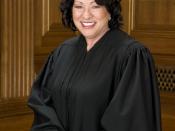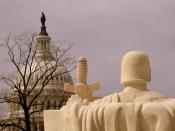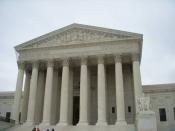The ongoing debate on the division of powers between the national government and the states began with the founding of the republic in 1787 and still continues today. In 1787 the debate over the division of power began with the federalists and the anti-federalists. More recently, the Republicans started an effort to slow the growth of the federal government by returning many of the functions back to the state, called the Devolution Revolution. The U.S. Supreme court continues to make decisions that have a direct impact on the power given to the states in relation to the federal government.
Although the political process has the final decision in how the power is divided between the national and state governments, the Supreme Court is often the final say in the debate about which level of government should do what, for whom, and to whom. This role was claimed for the Courts because of the outcome of McCulloch v. Maryland case, in which the state of Maryland levied a tax against the Baltimore branch of the Bank of the United States and was then challenged in court by James McCulloch.
McCulloch was a cashier of the bank who refused to pay the tax levied against the bank on the grounds that a state could not tax an instrument of the national government. In this case, it was decided by Chief Justice John Marshall to set forth the doctrine of National Supremacy, which states that in cases of conflict between the constitutionally authorized actions of the national government and those of the state or local governments, the actions of the federal government is supreme. In this decision, the Supreme Court dealt a great blow to a claim of states rights by rejecting a states attempt to interfere with a legitimate federal activity.


